Research Report: Binance's four major currency listing paths and subsequent CEX performance are fully disassembled

Reprinted from jinse
06/11/2025·6DAuthor: Retardiño, Source: IOSG Ventures
This study analyzed the token life cycle performance of Binance's four major currency listing channels - Alpha, IDO, Futures and Spot - and tracked its subsequent launch on Bitget, Bybit, Coinbase, and Upbit, focusing on the return performance, currency listing rhythm, track preference and FDV range.
1. Performance review
-
The median 14-day FDV in most channels is negative, reflecting that most projects are valuation highs when they are online;
-
Binance Alpha has the most explosive performance (average 220%), but has a lot of volatility;
-
Binance IDO has a well-balanced short-term gain and high conversion rates (to Futures and Spot);
-
Binance Spot performs the weakest in the short term, or is due to being an early-stage investor exit point;
-
Bitget and Coinbase performed well in the secondary market, while Bybit and Upbit were relatively average.
2. Press FDV interval to select the platform
-
Binance Spot prefers large-cap projects (>$500M);
-
Alpha mainly supports early projects with < $200M, suitable for testing the waters;
-
IDO focuses on the mid-sized projects of $70M–$200M;
-
Bitget/Bybit has flexible ranges, but is more inclined to projects with growth potential or large market capitalization;
-
Coinbase / Upbit prefers projects with strong compliance and high valuation.
3. Expected time for currency listing
-
Alpha → Spot: Average about 60 days;
-
IDO → Spot: Average about 17 days;
-
Futures → Spot: On average, only 14 days;
-
Futures may be the fastest channel.
4. Track preference
-
Alpha: Prefer Meme and AI;
-
IDO: Prefer Infra and AI;
-
Spot: Coverage Infra, Meme, AI;
-
Futures: More extensive, focusing on Infra, AI, Meme;
-
The project party needs to adjust the narrative direction according to the platform's preferences.
5. Advanced coin path
-
Alpha → Futures: Conversion rate 37.8%
-
Alpha → Spot: Conversion rate 12.2%
-
IDO → Futures: Conversion rate 66.7%
-
IDO → Spot: Conversion rate 23.8%
-
Achievement of about 40% of the FDV rise is a common feature of the platform entering the next stage.
6. Alternative platform performance
-
Bitget is the most responsive CEX, especially for Alpha/IDO projects;
-
Bybit also has a high willingness to undertake IDO projects;
-
There are very few projects online in Coinbase/Upbit, with strict reviews and a long cycle.
This study focuses on the life cycle performance of tokens in Binance’s online channels (Alpha, Exclusive TGE, Futures and Spot, which is commonly known as IDO in the community), and tracks the subsequent online paths of these projects on centralized exchanges (CEXs) such as Bitget, Bybit, Upbit, and Coinbase. The analysis content covers token return performance, launch timing, project track preferences and valuation distribution (FDV dynamics), aiming to provide project parties with strategic coin listing path recommendations, and also establish a data-based price discovery and trading strategy evaluation framework for investors.
Term Explanation: What does Binance's Spot/Futures/IDO/Alpha listing
mean?
Binance Spot is Binance's most basic trading platform. Users can buy or sell tokens at the current market price. Once the transaction is completed, the asset delivery can be completed and they can be held, transferred or sold freely.
Binance Futures (Contract) provides cryptocurrency derivatives trading services, where users can go long or short and use leverage to amplify gains or losses.
Binance IDO is a public offering channel for retail users. Users participate in the issuance of tokens on the BNB chain by pledging BNB or completing the Alpha Quest task set by the Binance team, which usually occurs before the tokens are officially launched on other platforms.
Binance Alpha is a token discovery platform launched by Binance, integrating Pancakeswap on BNB Chain and other on-chain DEXs to support projects with growth potential in the early stages, emphasizing experimentation and token diversity.
Research scope
Exchange selection: The projects tracked in this study were originally launched on the Binance series channels, and their subsequent online performance on Bitget, Bybit, Coinbase, and Upbit were also included in the survey. These platforms are the most common CEX after Binance.
Time limit: Only included in the online events after February 2025. This time point is used to filter out the market logic, which is more in line with the current online dynamics.
Whether for project parties or investors, it is extremely important to understand the token's online path:
-
For project parties, the performance of different platforms will directly affect resource deployment and online rhythm arrangement;
-
For investors, the performance of tokens on different platforms is an important basis for formulating position management and judging whether to chase high prices.
1. Price discovery
1.1 Rate of return
Indicator definition: In this section, we measure the rise and fall of FDV within 14 days after the token is launched to evaluate the short-term price discovery capabilities of different platforms. The FDV corresponding to the closing price of our first day of the online list is the benchmark, and compare the highest FDV in the 14th day.

Overall, the median FDV of all platforms on 14 days is negative, indicating that in the current cycle, most projects are online as the valuation high point.
-
Binance Alpha: The mean is about +77%, and the median is -7.6%. Most projects have limited returns, but a few have exploded extremely, showing the high fluctuation characteristics of Alpha. Although the performance is differentiated, the downward space is limited, and there is exposure to the project party and an asymmetric return structure for investors.
-
Binance IDO vs Futures: Medians are -16.3% and -21.7%, respectively, but mean is +28% and -20%. This shows that most projects perform in moderation, but individual projects have increased the overall mean. Futures performed weakly, mainly because most projects were added after a period of time, and have passed the peak of fluctuations.
-
Binance Spot: Median -29.7%, mean -20%. As the most prestigious platform, Spot's launch may become an exit point for early investors, resulting in price pressure.
-
Bitget and Coinbase: performed soundly, with Bitget median -19.8%, with an average of about 21%; Coinbase median -7.7%, with an average of about 18%. The two have a strong ability to bear momentum after Binance is launched.
-
Bybit and Upbit: The performance is moderate, the median Bybit is -22.1%, the mean is 8.9%; the median Upbit is -24.6%, the mean is -5%. Upbit is usually launched late, the project popularity has declined, and its performance is relatively weak.
1.2 Shocking amplitude
Indicator definition: This section measures the ratio of the highest FDV of the token to the online FDV within 14 days after it is launched, and is used to evaluate the short-term upward potential provided by each platform.
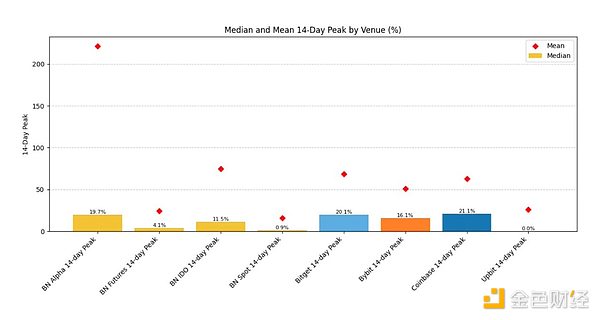
This indicator helps investors judge the rising potential of the token in the early stage of its launch, and also provides reference for project parties to understand market demand, selling pressure strength and the ability of each platform in price discovery.
-
Binance Alpha: The average surge rate is 220%, with a median of 19.7%. Some projects have only slightly fluctuated, but many projects have experienced sharp rises after they were launched, demonstrating Alpha's strong short-term speculativeness and price discovery capabilities, and are the channel with the strongest upward potential among all platforms.
-
Binance IDO: The average surge is about 75%, with a median of 11.5%. Most projects have good hype after they are launched.
-
Binance Futures: The average surge was 27%, with the median being only 4.1%. It has a certain amount of traffic import, which has a certain effect on price promotion, and is a good auxiliary exposure platform.
-
Binance Spot: The performance was unsatisfactory, with an average increase of only 15%, and a median of 0.9%. Because market expectations have been fulfilled, the project encountered strong selling pressure as soon as it was launched.
-
Coinbase: The average surge was 60%, with a median of 21.1%. Among all CEXs, the catalytic effect is the strongest, mainly benefiting from the US user base, but the frequency of listing is low.
-
Bybit / Bitget: The average rise is 70-80%, the median is around 20%, the speculative atmosphere is strong and the short-term fluctuations are obvious, which is a very good choice for listing coins.
-
Upbit: The average surge is 35%, and the median is 0%. The transaction depth is weak and the user enthusiasm is relatively limited.
2. FDV distribution at market
This section starts from the FDV distribution of projects launched on each platform and provides project parties with path planning suggestions. Projects at different valuation stages are suitable for different online channels. Understanding the platform's FDV acceptance range will help the team more accurately match the online rhythm and platform strategy.
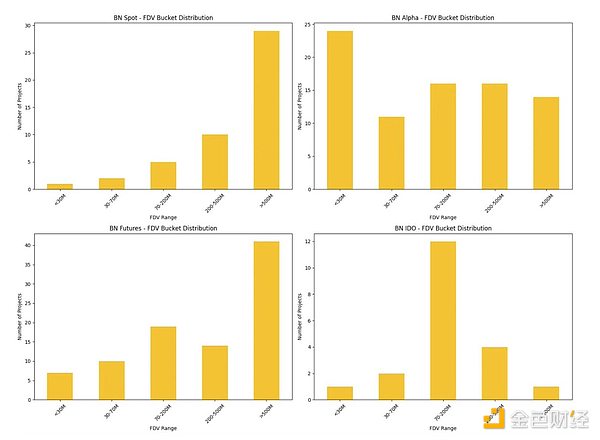
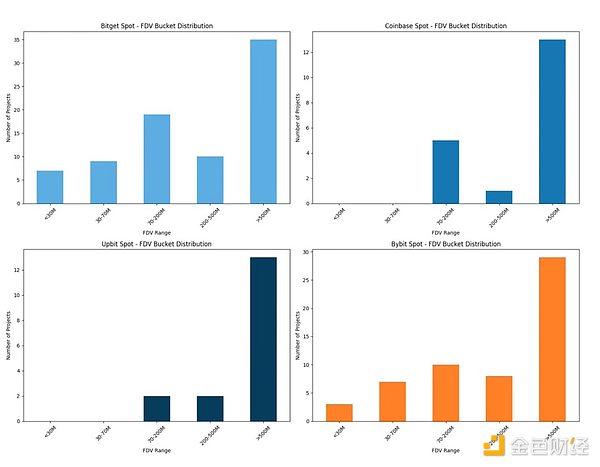
-
Binance Spot: More than 60% of projects have FDVs of more than $500 million, and they obviously prefer large-cap projects. The platform has high requirements for the project size and investment institution background, and is more suitable for mature projects with a scale of valuation.
-
Binance Alpha: The coverage range is wide, and FDV is mostly concentrated below US$200 million. It conforms to the Alpha "experimental field" positioning and is suitable for projects with early valuation but with potential.
-
Binance Futures: More than half of the projects have FDVs of more than $500 million, but there is also a certain distribution in the range of $70 million to $500 million. Futures is more like a follow-up channel for listed projects, suitable for projects with relatively stable valuations.
-
Binance IDO: FDV is mostly concentrated between 70 million and 200 million US dollars, indicating its preference for market capitalization projects. Suitable for public offerings when products, communities and strategies are well prepared.
-
Bitget: Covering the complete valuation range from below 30 million to above 500 million, with concentrated distribution between 70 million-200 million and above 500 million. This means that the platform has a high acceptance, but prefers mid-cap projects that have already become popular or endorsed by institutions.
-
Bybit: Nearly half of the projects have FDVs above $500 million, and the range of $70 million to $200 million is also well covered. Have the dual ability to undertake short-term popularity and promote medium-cap projects.
-
Coinbase: The project FDV is almost all higher than US$500 million, reflecting its compliance threshold and high market value preference. The platform is more suitable for mature and highly compliant projects.
-
Upbit: All online projects are above US$200 million, and most of them exceed the US$500 million threshold. This shows that the Korean market has high market value requirements and is more suitable as a later supplement channel.
3. Platform track preferences
Project parties need to understand the differences in the preferences of different platforms in track selection. The following analysis only focuses on the distribution of Binance's four major channels in the track dimension.
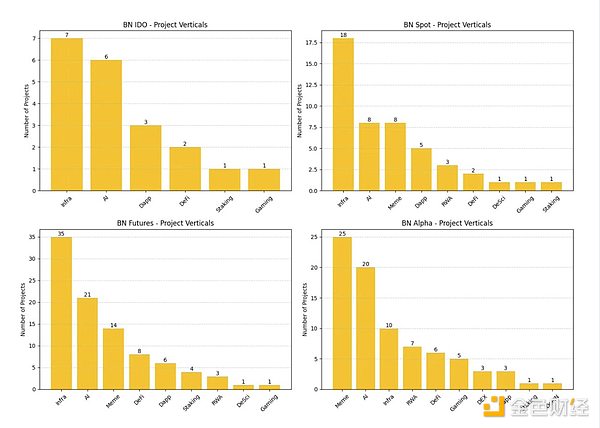
In addition, the total number of online projects from different channels also reflects the difficulty of online projects. Usually, the fewer projects a platform has, the stricter its screening criteria.
-
Binance Spot: About 50 projects are available online
-
Binance Futures: About 90 projects are available online
-
Binance Alpha: About 80 projects are available online
-
Binance IDO: About 20 projects are available online
Binance IDO:
-
Preferences to Infra (7 items) and AI (6 items).
-
The vertical distribution is concentrated, covering only 6 tracks.
-
It focuses clearly on the underlying technology and emerging application scenarios, and prioritizes support for infrastructure and AI projects.
Binance Spot:
-
Preferences to Infra (18 items), Meme (8 items), and AI (8 items).
-
At the same time, it covers multiple subcategories such as DeFi, RWA, GameFi, Dapps, etc.
-
Vertical distribution is the most balanced, but infrastructure projects still dominate.
Binance Futures:
-
It is the platform with the most online projects, covering 35 Infra and 21 AI projects.
-
Meme (14) and DeFi (8) account for a large proportion.
-
The track covers a wide range and prefers projects with active market and narrative-driven development.
Binance Alpha:
-
Focusing on Meme (25) and AI (20), highlighting speculative narratives and experimental themes.
-
The number of Infra projects is 10, including RWA (5), DeFi (4), GameFi, etc.
-
Alpha is a test site for hype and conceptual projects.
summary:
-
The project party needs to adjust product positioning and market narrative according to the vertical preferences of each platform.
-
AI projects are a popular track supported by all four major channels.
-
The Meme project dominates Alpha and has good coverage in Spot and Futures.
-
The Infra project is the most inclusive core track besides Alpha.
4. Listing path analysis
Many project parties will ask a key question: Can Alpha or IDO be a springboard for entering Binance Spot? Let's look at the data and speak:
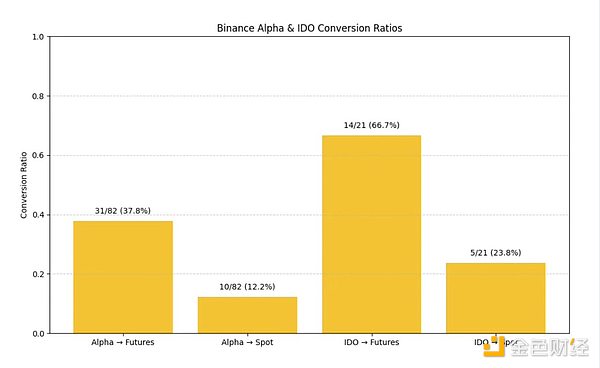
-
Alpha → Futures: The conversion rate is 37.8% (31/82), which is a relatively effective front-end channel.
-
Alpha → Spot: The conversion rate is only 12.2% (10/82), which is lower overall.
-
IDO → Futures: The highest conversion rate reached 66.7% (14/21).
-
IDO → Spot: The conversion rate is 23.8% (5/21), better than Alpha.
Alpha is more suitable as an early test channel. More than 30% of projects have successfully entered Futures, but to be promoted to Spot, strong fundamentals and market performance are still needed. In contrast, the IDO project is more solid based on brand awareness and community and has higher promotion potential. Project parties should regard Alpha and IDO as the starting point, not the end point, to enter the Binance system.
4.1 Project performance threshold
How did those projects that successfully advance from Alpha/IDO to Binance Spot perform in the early stages? Are there any rules to learn from?
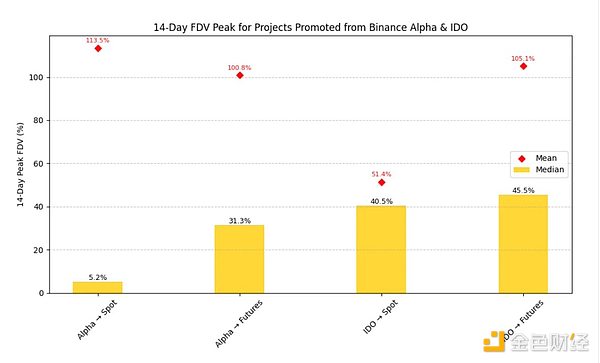
-
Alpha → Spot: The project's 14-day highs in the Alpha phase were only 5.2%, which is much lower than 30–50% of other paths, but its average is as high as 113.5%, the highest of all paths. This shows that the project performance is extremely differentiated, and some projects have extremely strong explosive power, but most of them have limited growth. The launch of Binance Spot does not rely entirely on market speculation, but focuses more on hard indicators such as product quality and user data.
-
Alpha → Futures and the two IDO paths (→ Spot and → Futures) were relatively concentrated in the 14-day high-end median, about 30–45%, and the mean was between 51%–105%, and the performance was stable.
Overall, if the project can achieve a FDV rise of about 40–50% within two weeks after the front-end platform is launched, it is more likely to gain further favor from Futures or Spot. This can be used as a reference standard for project parties to evaluate their subsequent listing potential.
4.2 Waiting time
Project parties also need to set reasonable expectations: How long does it usually take to go from Alpha or IDO to Binance Spot to go public? Lack of clear time planning may lead to missing market windows or losing community attention.

-
Alpha → Spot: The average wait is about 60 days, and some projects even exceed 120 days. The overall distribution is wide, which means that the path is not predictable and is more suitable as a platform for the exploration stage rather than a springboard to Spot directly.
-
Alpha → Futures: It takes only 30 days on average, and the pace is significantly faster than Spot, with stronger market response efficiency.
-
IDO → Spot and IDO → Futures: The average waiting time is 17 days, and most projects can be completed within 1 month after they go online. Thanks to its strong community mobilization and unified rhythm arrangement, the IDO project has relatively controllable rhythm in the subsequent currency listing path.
-
Futures → Spot: Fastest of all paths, with an average of only 14 days, and a highly concentrated time distribution.
If the team's goal is to quickly achieve Binance Spot listing, Futures is the most certain transit path currently observed.
5. Alternative path: Entering other CEXs
Not all projects have Binance Spot as their sole goal. More and more projects are turning to mainstream platforms such as Bitget, Bybit, Coinbase, Upbit after Alpha or IDO. Some platforms have quick response and considerable liquidity, becoming an actual alternative.
5.1 Number of listings
How many projects have successfully entered other mainstream CEXs after Alpha or IDO?
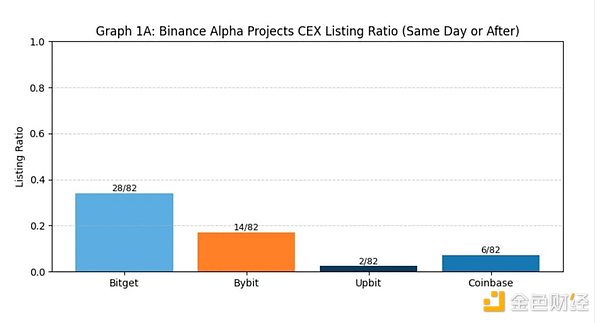
- Alpha → Bitget: The online rate is 34.1% (28/82), far ahead. Bybit is 17.1% (14/82), Coinbase is 6% (6/82), Upbit only has 2 related projects online.
Bitget has the highest acceptance of Alpha projects, probably due to its openness to emerging projects and its flexible threshold for launch. Bybit also showed some interest in the Alpha project.
- IDO → Bitget and Bybit: The online rates were 61.9% (13/21) and 47.6% (10/21), Upbit was 9%, and Coinbase had no records.
Compared to Alpha, the IDO project is more attractive on other platforms, which may be related to its stronger brand building and community potential. Bitget and Bybit also have stronger ability to undertake IDO projects, which is an extension path worthy of the project's focus.
5.2 Waiting time for listing
After a project launches Binance from Alpha or IDO, how long does it usually take to follow up and go online on mainstream CEX?

-
Bitget: The average Alpha project is about 14 days, and the IDO project is faster, only 13 days. Many IDO projects were launched simultaneously on TGE on the same day.
-
Bybit: The Alpha project lasted about 13 days, and IDO was also launched on TGE on the same day.
-
Coinbase: Only the Alpha project is online, with an average of about 29 days.
-
Upbit: Only IDO projects are online, with an average of about 31 days.
Bitget and Bybit are fast-paced and are suitable for fast-paced online; Coinbase and Upbit are slower and need to be coordinated with local compliance and community rhythm.
5.3 Price discovery capability of other CEXs
The following figure shows the average 14-day increase in Alpha and IDO projects after each CEX is launched:
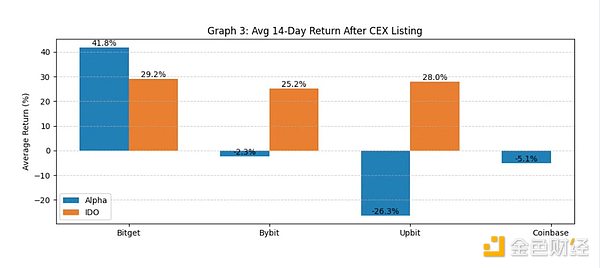
-
Bitget: Alpha project returns 41.8%, and IDO project 29.2%, with the best performance.
-
Bybit: Alpha project is -2.3%, IDO project is 25.2%, prefer IDO.
-
Coinbase and Upbit: The sample items are 6 and 4 respectively, with large statistical deviations and not representative.
Bitget and Bybit have performed stably in taking on Binance projects and are important consideration platforms for project parties to plan TGE routes.
in conclusion
Overall, Binance Alpha and IDO are good front-end platforms within Binance:
-
Alpha is more like an experimental field, with a low entry barrier and suitable for early project exposure;
-
IDO has stronger brand endorsement, and Futures and Spot also have higher conversion rates.
But Spot conversion is still scarce: the final promotion rate of the Alpha project is only about 12%, and the IDO is only 24%. Project parties need to do a good job of rhythm management:
-
Alpha → Spot waits about 60 days on average,
-
IDO → Spot is 17 days,
-
Futures → Spot is fastest, in just 14 days.
In addition, different platforms' preference for project FDV also emits key signals:
-
Spot prefers large-cap projects with valuations above $500M;
-
Alpha mainly accepts early-stage projects with valuations below $200M;
-
IDO is mostly concentrated in the range of $70M–$200M, suitable for medium-sized projects with clear preparation.
The project party should choose appropriate channels based on its own valuation stage to match liquidity expectations and market rhythm.



 chaincatcher
chaincatcher

